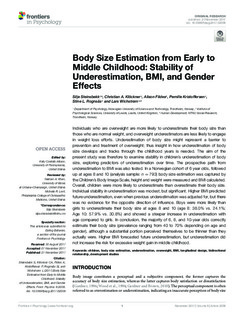| dc.contributor.author | Steinsbekk, Silje | |
| dc.contributor.author | Kløckner, Christian | |
| dc.contributor.author | Fildes, Alison | |
| dc.contributor.author | Kristoffersen, Pernille | |
| dc.contributor.author | Rognsås, Stine Leming | |
| dc.contributor.author | Wichstrøm, Lars | |
| dc.date.accessioned | 2017-12-13T07:32:17Z | |
| dc.date.available | 2017-12-13T07:32:17Z | |
| dc.date.created | 2017-12-07T13:26:04Z | |
| dc.date.issued | 2017 | |
| dc.identifier.issn | 1664-1078 | |
| dc.identifier.uri | http://hdl.handle.net/11250/2470922 | |
| dc.description.abstract | Individuals who are overweight are more likely to underestimate their body size than those who are normal weight, and overweight underestimators are less likely to engage in weight loss efforts. Underestimation of body size might represent a barrier to prevention and treatment of overweight; thus insight in how underestimation of body size develops and tracks through the childhood years is needed. The aim of the present study was therefore to examine stability in children’s underestimation of body size, exploring predictors of underestimation over time. The prospective path from underestimation to BMI was also tested. In a Norwegian cohort of 6 year olds, followed up at ages 8 and 10 (analysis sample: n = 793) body size estimation was captured by the Children’s Body Image Scale, height and weight were measured and BMI calculated. Overall, children were more likely to underestimate than overestimate their body size. Individual stability in underestimation was modest, but significant. Higher BMI predicted future underestimation, even when previous underestimation was adjusted for, but there was no evidence for the opposite direction of influence. Boys were more likely than girls to underestimate their body size at ages 8 and 10 (age 8: 38.0% vs. 24.1%; Age 10: 57.9% vs. 30.8%) and showed a steeper increase in underestimation with age compared to girls. In conclusion, the majority of 6, 8, and 10-year olds correctly estimate their body size (prevalence ranging from 40 to 70% depending on age and gender), although a substantial portion perceived themselves to be thinner than they actually were. Higher BMI forecasted future underestimation, but underestimation did not increase the risk for excessive weight gain in middle childhood. | nb_NO |
| dc.language.iso | eng | nb_NO |
| dc.publisher | Frontiers Media | nb_NO |
| dc.relation.uri | file:///C:/Users/wichstro/Downloads/fpsyg-08-02038.pdf | |
| dc.rights | Navngivelse 4.0 Internasjonal | * |
| dc.rights.uri | http://creativecommons.org/licenses/by/4.0/deed.no | * |
| dc.title | Body Size Estimation from Early to Middle Childhood: Stability of Underestimation, BMI, and Gender Effects | nb_NO |
| dc.type | Journal article | nb_NO |
| dc.type | Peer reviewed | nb_NO |
| dc.description.version | publishedVersion | nb_NO |
| dc.source.journal | Frontiers in Psychology | nb_NO |
| dc.identifier.doi | 10.3389/fpsyg.2017.02038 | |
| dc.identifier.cristin | 1524232 | |
| dc.relation.project | Norges forskningsråd: 213793 | nb_NO |
| dc.description.localcode | t © 2017 Steinsbekk, Klöckner, Fildes, Kristoffersen, Rognsås and Wichstrøm. This is an open-access article distributed under the terms of the Creative Commons Attribution License (CC BY). The use, distribution or reproduction in other forums is permitted, provided the original author(s) or licensor are credited and that the original publication in this journal is cited, in accordance with accepted academic practice. No use, distribution or reproduction is permitted which does not comply with these terms. | nb_NO |
| cristin.unitcode | 194,67,40,0 | |
| cristin.unitname | Institutt for psykologi | |
| cristin.ispublished | true | |
| cristin.fulltext | original | |
| cristin.qualitycode | 2 | |

